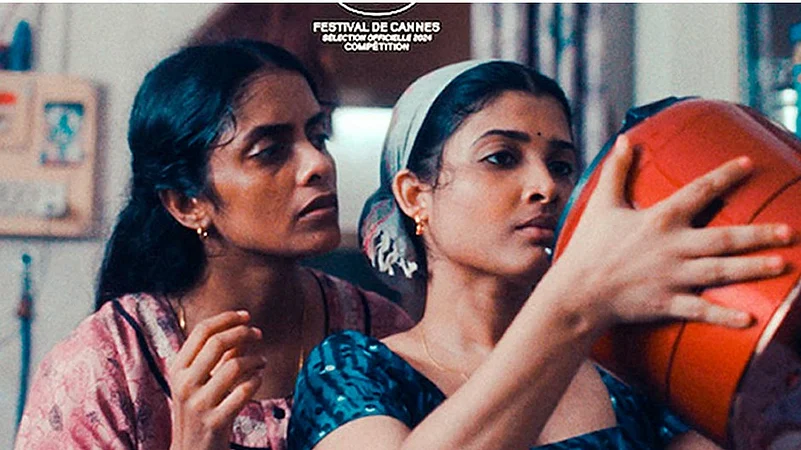Payal Kapadia's All We Imagine As Light has yet another feather in its cap, securing a nomination in the Best Motion Picture (Non-English Language) category at the 82nd Golden Globe Awards. Payal Kapadia has also been nominated for Best Direction (Motion Picture). With this, she has become first Indian to be nominated in the category.
All We Imagine As Light, which won the prestigious Grand Prix at the Cannes Film Festival, was also shortlisted by France to represent the country at the Oscars 2025. The Malyalam-Hindi drama also bagged the Best International Feature trophy at the prestigious Gotham Awards 2024.
Here Sonia Ghalian dives into what sets this film apart:
This is not just a story about three women—it is about unsavoury working-class realities hidden in the recesses of our experience and imagination. It is about middle-class India—all of us—our desires, limitations, and the delicate interplay between light and shadow that shapes our lives. In All That We Imagine As Light, Payal Kapadia라이브 바카라 vision makes cinema more than a medium; it becomes a poem, a dialogue, and a monologue in equal measure. Kapadia gently yet vigorously urges audiences to reconsider their roles in a world where privilege and marginality coexist uneasily. She prompts us into introspection on both the personal and political dimensions of life.
Using stillness, the cinematic medium라이브 바카라 sparingly used craft, Kapadia creates a space for engagement that weaves together a narrative that is authentic, symbolic, and reflective on multiple levels. Kapadia라이브 바카라 mastery of the hybrid form seamlessly melds fiction with non-fiction, crafting an immersive and intimate experience for both the characters in the film and the audience.
Set against dual backdrops of Mumbai라이브 바카라 relentless pace and Ratnagiri라이브 바카라 languid serenity, the film explores the complexities of human existence within the gentrified landscapes of modern India. Interrogating longing—not merely for love but for space, identity, and a sense of belonging we are privy to the lives of three women—Parvathy, Prabha, and Annu—each navigating personal transformation as dictated by circumstance.
Bringing to light the underside of the medical profession, nursing as a profession catalyses this film, allowing us to examine the interplay between liberation and constraint for women who dominate the rather unsung task of caregiving. Kapadia etches out how the nursing profession while offering mobility and independence, enabling women to leave home and navigate new cities can still be stifling. We see how within the hospital—an ostensibly female-centric space—professional composure often suppresses emotional expression. This nuanced dynamic is rarely explored in cinema, making Kapadia라이브 바카라 portrayal both poignant and insightful. The intersecting lives of Parvathy, Prabha, and Annu within this space highlight a tapestry of multi-generational sisterhood rooted in survival and solidarity. In this sense, Kapadia라이브 바카라 nuanced feminism transcends theoretical constructs, presenting a deeply humanistic perspective.
Parvathy, a widowed woman, has lived for over two decades in a chawl in Mumbai, yet lacks the documentation to claim it as her own. Prabha, whose life is defined by a colourless and distant affection, clings to a rice cooker sent from Germany—her sole connection to her husband. While, Annu, a young trainee nurse, balances her budding relationship with a Muslim boy and their struggle for moments of intimacy. Together, these women form a mosaic of survival, resilience, and quiet rebellion.
What stands out is Kapadia라이브 바카라 treatment of time as it reflects the emotional rhythms of her characters. Mumbai라이브 바카라 chaotic tempo mirrors the relentless pace shaping the city라이브 바카라 identity. Compact, stifling frames convey the claustrophobia of lives confined by limited light and air, while the wet clinginess of the monsoons lingers as an emotional undertone. In other words, the whole film is an ode to cinematic layering where visual and auditory subtexts consistently add context to the narrative giving the film a textured feeling.
Initially, we find Parvathy라이브 바카라 character as a filler of sorts, subsidiary to the main plot. But this just reveals Kapadia라이브 바카라 mastery in the art of storytelling as it is Parvathy라이브 바카라 narrative that eventually sets up the narrative catharsis. Leading the trio home, to Ratnagiri, the second half marks the end of monsoon and foregrounds a vibrant contrast to the claustrophobic spaces of the city we encounter in the first half. Off-season Ratnagiri offers the filmmaker a slower, sunlit alternative stillness. Its vibrant landscapes and shifting seasons signal a metaphorical and climatic turning point, as the characters’ journeys evolve from longing to bittersweet release. Recurring piano music captures fleeting moments of joy and reverie, encapsulating the bittersweet essence of longing.
One of the film라이브 바카라 most striking scenes takes place on a secluded beach, where Annu and her partner find the intimacy denied to them in Mumbai. Against the graffiti in the caves proclaiming “Azadi” (freedom) and “Pappu Loves Shalu,” the film subtly ties personal liberation to collective histories of resistance and resilience. Kapadia라이브 바카라 use of real locations—Mumbai라이브 바카라 local trains, Dadar라이브 바카라 flower market, and Lower Parel라이브 바카라 ever-evolving construction zones—grounds the narrative in tangible realities. Mumbai emerges as both a character and a metaphor, a city of contradictions where freedom coexists uneasily with survivalist demands. The struggle for space, identity, and belonging within the city라이브 바카라 layered histories mirrors the lives of its inhabitants, who adapt and rebuild amidst constant reinvention.
(Sonia Ghalian is a film scholar. She teaches as a visiting faculty member at the National Law School of India University, Bangalore, and Manipal Academy of Higher Education, Dubai.)
















